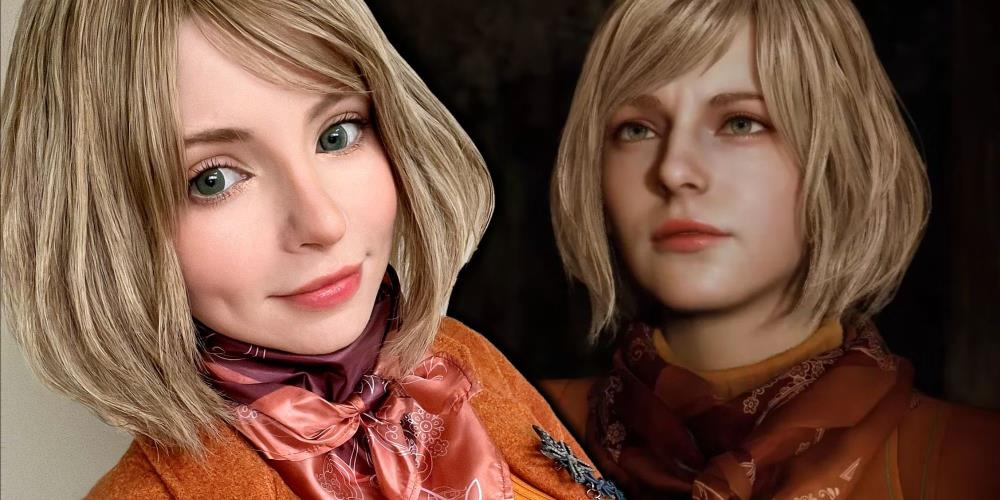Have you ever found yourself wondering about the faces and forms behind your favorite digital characters? It's a pretty common thought, actually. When a character feels so real, so lifelike, you just might start to think about the people who helped bring them into being. This curiosity, you know, it often leads to questions about who exactly provided the physical inspiration for these digital creations. So, if you're asking, "Who was the body model for Ashley?", you're certainly not alone in that particular line of thinking. There's a lot that goes into making these digital people seem real, and the role of a body model is, arguably, quite important in that process.
It's interesting how we connect with characters, isn't it? Whether it's from a video game, a movie, or even an advertisement, a well-crafted character can really stick with you. Sometimes, people are curious about the real individuals who might have lent their appearance to a digital figure. It’s a bit like trying to find out the specific mechanical parts, like Mopar engine parts or a transmission, that make a classic car run so smoothly, just on a different level. You want to know the components that make the whole thing work, and that includes the human element.
The question of who served as a body model for a character named "Ashley" can be a bit tricky, though, because there are quite a few famous "Ashleys" out there, and the term "body model" can mean different things. For instance, Ashley Graham is a well-known model herself, so in her case, she *is* the body model. But if you're thinking about a fictional character named Ashley, like from a popular video game, then the question gets, you know, a little more specific. It's about figuring out who helped shape that digital persona, and that can sometimes involve a bit of digging, much like when you're seeing conflicting answers in your research about something else entirely, which just further confuses the issue.
Table of Contents
- Understanding Body Modeling in Digital Creation
- The Case of Ashley Graham: A Model Named Ashley
- Ashley from Resident Evil 4: Unveiling the Inspiration
- Why Use Body Models in Character Design?
- The Difference Between Face and Body Models
- Finding Information: The Challenges of Crediting Digital Inspirations
- The Evolution of Character Creation and the Role of Models
- FAQs About Body Models and Digital Characters
- The Impact of Body Models on Character Realism
Understanding Body Modeling in Digital Creation
Body modeling in the world of digital art is, in a way, a pretty fascinating process. It's where a real person's physique, their movements, and sometimes even their expressions are used as a guide to create a digital character. This can involve anything from simple photographic references to advanced motion capture technology. The goal, typically, is to make the digital character look and move as believably as possible. It's not just about getting the shape right; it's also about capturing the nuances of human movement, you know, the way a person carries themselves or how their clothes might fall. This attention to detail is, arguably, what makes a character truly come alive on screen.
When artists are trying to build a character, they often need a solid foundation. That's where body models come in. They provide that real-world reference, helping to ensure that the character's proportions, musculature, and overall posture feel natural. It's a bit like making sure your Mopar performance bracket set, PN P3690454 & 455, bolts right up to the MP hanger bracket; you need things to fit together just right for the whole system to work properly without causing a short, as a matter of fact. Without that real-world reference, it can be much harder to achieve that convincing level of realism.
The Case of Ashley Graham: A Model Named Ashley
When someone asks about "Ashley" and a body model, one of the first names that might pop into your head is Ashley Graham. She's, you know, a very famous and influential supermodel. In her case, the question "Who was the body model for Ashley?" is a bit of a trick question, because she *is* the body model. She's known for her work in fashion, advertising, and for being a strong advocate for body positivity and inclusion in the modeling industry. So, if you're talking about *her*, then the answer is quite straightforward: she models her own body.
Her career really shows how a person can become, essentially, a global icon just by being themselves and, you know, presenting their authentic self. She's been on countless magazine covers and in major campaigns, always, you know, representing a broader vision of beauty. It's pretty cool how she's changed the conversation around body image in the fashion world, actually. Her influence is, in some respects, quite significant, demonstrating that true beauty comes in all forms.
Ashley from Resident Evil 4: Unveiling the Inspiration
Now, if your question "Who was the body model for Ashley?" refers to a fictional character, like Ashley Graham from the popular video game *Resident Evil 4*, then we're talking about a different kind of situation entirely. Video game characters, especially in games with realistic graphics, often use real people as references for their appearance. This helps the artists create characters that feel grounded and believable. For Ashley Graham, the president's daughter in *Resident Evil 4*, there were indeed real people who helped bring her to life on screen. It's a process that involves a lot of artistic skill and, you know, technical know-how.
The development of a character like Ashley involves many steps. Artists might use photographs of models, or even scan their bodies in 3D, to get the proportions just right. It's a very detailed process, and it helps to make sure the character looks consistent from every angle. This is, you know, really important for immersion in a game. It's a bit like assembling a classic Mopar; you need all the right pieces, from the engine parts to the suspension, to make it run like it should.
Jody Johnson: The Body Model for Ashley Graham
For the character of Ashley Graham in *Resident Evil 4*, it's widely recognized that Jody Johnson served as the body model. While the character's face was based on another individual, Shinsaku Iwase, Jody Johnson provided the physical reference for Ashley's overall build and movements. This is a common practice in game development, where different models might be used for different aspects of a character's appearance. It allows creators to, you know, pick the best features from various sources to create their ideal digital person.
Jody Johnson's contribution was, you know, quite important in giving Ashley her distinct physical presence in the game. Her work helped define how Ashley moved, how she stood, and, you know, how she interacted with the environment. It's a very specialized kind of modeling, and it requires a keen understanding of how the human body moves. She helped give Ashley that realistic feel, which, arguably, added a lot to the game's atmosphere. It's pretty cool how these behind-the-scenes roles come together to create something so, you know, impactful.
Personal Details and Bio Data: Jody Johnson
Gathering comprehensive public personal details for body models can be, you know, a bit challenging, as their roles are often more private than those of, say, a celebrity actor. However, here's what's generally known or understood about Jody Johnson in relation to her work on *Resident Evil 4*:
| Name | Jody Johnson |
| Known For | Body model for Ashley Graham in *Resident Evil 4* |
| Role in Game Dev | Provided physical reference for character's body and movements |
| Industry | Video Game Development, Modeling |
| Notable Work | *Resident Evil 4* (Ashley Graham body) |
| Privacy | Like many behind-the-scenes contributors, details of her personal life are generally kept private. |
It's worth noting that while some models become quite famous, many others work behind the scenes, providing their talents without, you know, becoming public figures themselves. This is, in a way, very typical for these kinds of specialized roles in creative industries. You know, it's not always about being in the spotlight; sometimes it's about contributing to something larger, which is pretty neat.
Why Use Body Models in Character Design?
There are a lot of good reasons why game developers and animators use body models. For one, it saves a lot of time and effort. Instead of having artists try to imagine every curve and muscle, they can just use a real person as a guide. This helps ensure that the character's anatomy is, you know, correct and believable. It's a bit like having a blueprint for a complex machine; it makes the building process much smoother and more accurate. This approach really helps in making sure the final product looks polished, which is, you know, very important for modern graphics.
Another big reason is realism. Our brains are, you know, very good at spotting things that look "off" in human figures. Even a slight inaccuracy can make a character seem fake or unnatural. Using a real body model helps to avoid these pitfalls, giving the character a more authentic feel. This is especially true for motion capture, where a model's actual movements are recorded and then applied to the digital character. It’s about getting that natural flow, that human touch, which, arguably, adds so much to the experience. It's pretty amazing how much detail they can capture now, you know.
Also, it can help with consistency. When multiple artists are working on the same character, having a consistent reference point like a body model helps ensure that the character looks the same across different scenes or animations. This is, you know, really important for maintaining a cohesive visual style throughout a game or film. It's a bit like making sure all your Mopar engine parts are from the same series so they fit together perfectly; consistency is, you know, key for proper function.
The Difference Between Face and Body Models
It's pretty common for a digital character to have different models for their face and their body. This might seem a little odd at first, but it makes a lot of sense when you think about it. The face is, arguably, the most expressive part of a human. It conveys so much emotion, and it's where most of our attention goes when we're looking at a person. Because of this, developers often want to capture very specific facial features or expressions, which might require a dedicated face model. This is, you know, a very specialized skill, capturing those subtle nuances.
The body, on the other hand, is about overall physique, posture, and movement. While important for realism, it doesn't always require the same level of specific feature matching as the face. So, a game studio might, you know, use one person for their face and another for their body. This allows them to pick the best of both worlds, creating a character that has, say, a very striking face and a very natural-looking body. It's a bit like how a Gran Fury was a C body, but the Satellite replaced the Fury as the top price class Plymouth B body for 1965; different parts serving different, yet equally important, roles in the overall design, which further confuses the issue sometimes when you're trying to track down all the details.
This separation also gives creators more flexibility. They can mix and match, you know, to achieve a unique look that might not be possible with just one model. It's all about achieving that perfect blend of realism and artistic vision. This approach has, in some respects, become a standard practice in high-end character design. It really shows how much thought goes into every little detail, which is pretty cool.
Finding Information: The Challenges of Crediting Digital Inspirations
Trying to find out who the body model was for a specific character can be, you know, surprisingly difficult sometimes. Unlike actors who are usually credited prominently, models who provide references for digital characters don't always get the same public recognition. This is for a few reasons. Sometimes, it's because their role is considered more technical or behind-the-scenes. Other times, it might be due to privacy agreements or, you know, the way contracts are structured.
Also, the information might be buried deep in game credits, or only mentioned in interviews with developers that are, you know, hard to find. It's a bit like trying to track down specific details about a classic car; you might have to dig through old forums or, you know, very specialized communities. You know, you're seeing conflicting answers in your research, and it can be a real puzzle. This lack of clear public information can make it tough for fans who are just curious about the people behind their favorite characters.
Furthermore, the creative process itself can be quite fluid. A character might start with one model as a reference, but then artists might make significant changes, or even combine elements from several different people. So, pinpointing one single "body model" can be, you know, a bit oversimplified in some cases. It's a complex process, and the final character is often the result of many different contributions. This is, you know, why the answer isn't always as simple as you might think.



